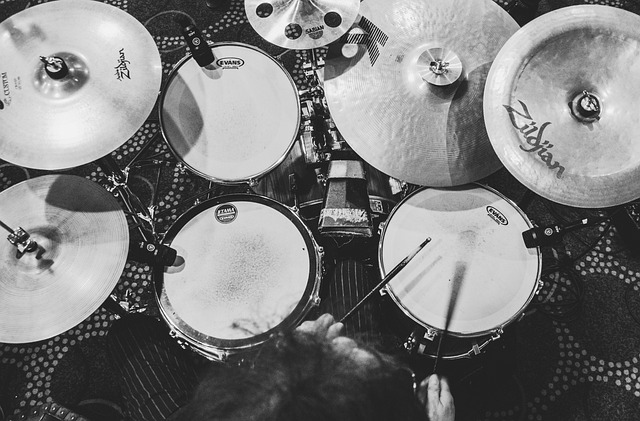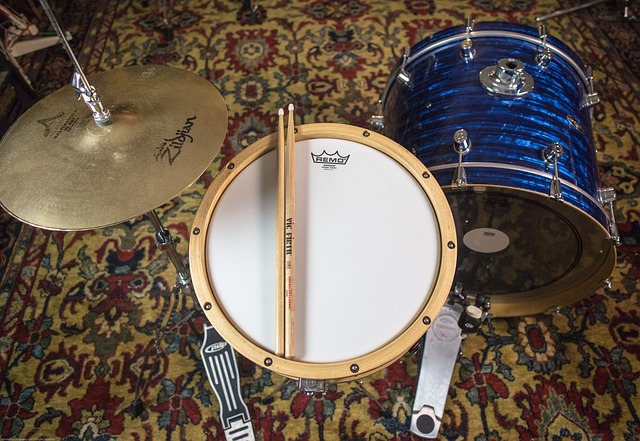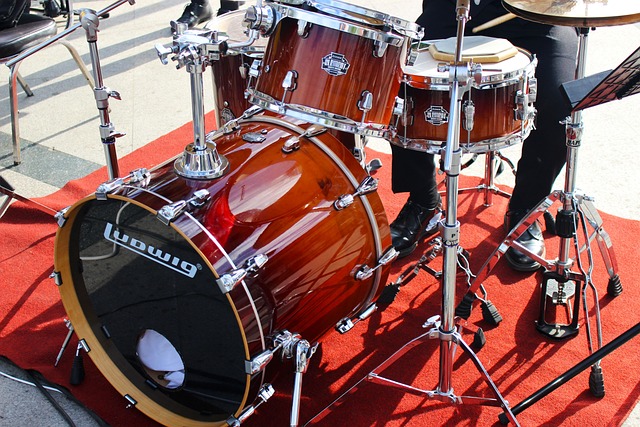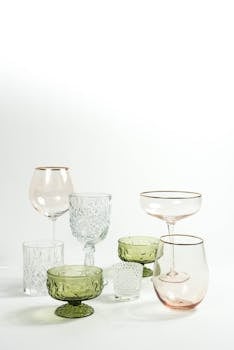Drum Set Sticks
Choosing the Right Drum Sticks
Choosing the right drumsticks is essential for any drummer — whether you’re a beginner or a seasoned professional. The type of stick you select fundamentally impacts your playing style, technique, and overall sound.
First, consider the material. Most drumsticks are made from wood, with hickory and maple being the most common choices. Hickory is robust and absorbs shock well, making it a solid choice for versatility and endurance. Maple is lighter and offers a faster response, but it can wear out quicker. If you’re exploring different genres or techniques, experimenting with both can yield advantageous insights.
Next, pay attention to the size. Drumsticks come in various lengths and diameters, often denoted by a number and a letter (e.g., 5A, 2B). Smaller sizes like 5A are popular for their balance and control, while larger sizes like 2B offer more power and volume. Ultimately, it boils down to your personal preference and comfort. Holding different sticks and playing around with them is the best way to discover what works for you.
Tip: The tip shape plays an important role as well. Rounded tips produce a brighter sound, while acorn tips provide a warmer tone. Match the tip shape with your playing style and the music genre to maximize sound quality. If you play pop or funk, try out thinner tips for a sharper attack; for rock, a larger, rounder tip could give you the punch you need.
Another essential consideration is the finish on the stick. Some come polished while others are raw. Raw drumsticks offer more grip and control, particularly when playing complex rhythms, while polished sticks allow for faster movement but can feel slippery. Grass and nylon tips also offer different playing experiences; nylon is durable and can produce a brighter sound on cymbals.
Finally, consider your playing environment. If you’re performing in loud settings, denser materials or heavier sticks might work best. For quieter practices or soft styles, lighter sticks may be preferable. Choosing the right drumsticks isn’t a one-size-fits-all situation, so be mindful of experimentation and personal preference.
How to Properly Grip Drum Sticks
Finding the right grip for your drumsticks is essential for effective drumming. The grip influences your control, speed, and overall sound. I personally recommend the traditional grip, especially for beginners and jazz drumming. In traditional grip, you hold one stick with an underhand grip and the other with an overhand grip. This position allows for greater wrist mobility and a softer touch, which is wonderful for nuanced playing.
For a more common grip, consider the matched grip where both sticks are held in the same way. This grip uses a 90-degree angle with your hand, allowing you to use your fingers for quicker response and dynamics. With matched grip, your wrists do more of the work, which can be essential for achieving speed.
Placement is crucial: the fulcrum point of the stick—roughly one-third from the butt end—should rest between your thumb and index finger. Using your fingers to control the stick is a game-changer. Your ring finger and pinky can help stabilize the stick, giving you better control over rebounds.
Make sure you’re not gripping too tightly. A loose grip allows for greater agility and reduces fatigue. The idea is to feel connected to the stick rather than rigid. Practice holding the sticks lightly and letting them bounce off the drumheads to get comfortable with the motion.
Don’t forget about your wrist movement. Your wrists should lead the motion, while your fingers adjust for precision. Incorporate exercises that focus on wrist movement to develop muscle memory. Also, vary your grip occasionally to find what feels best during different styles of music.
Experimenting with stick thickness and weight also plays a role. Heavier sticks may require a different grip and can influence your sound significantly. I suggest trying out different sizes to find what suits your comfort level and musical style.
Ultimately, mastery of grip will come with time and practice. Regularly check your grip during practice sessions and adjust as needed. Your grip isn’t static; it evolves as you grow as a drummer. Stay aware, and refine your technique for better performance.
Caring for Your Drum Sticks
Properly caring for your drum sticks can significantly enhance your playing experience and prolong their lifespan. First, always store your drum sticks correctly. Avoid throwing them haphazardly into bags or leaving them exposed to extreme temperatures. A dedicated stick bag can protect them from damage and keep them organized for quick access.
Next, consider the type of wood used in your sticks. Drum sticks made of hickory or maple each have their specific maintenance needs. Hickory is tougher and less prone to breakage, while maple is lighter, offering a different feel but requiring more careful handling. Understanding this will shape how you treat them.
Humidity also affects wood sticks. Keep your sticks in a dry place, as moisture can weaken them over time. If you play in varied environments, let them acclimate to the conditions before use. This will reduce the chances of warping.
Another aspect is the grip. If you notice slippery grips, consider using stick grips or tacky tape. This not only provides a better hold but can also prevent slippage that may cause drops or accidents.
Lastly, be aware of wear and tear. Inspect your sticks regularly for dents, cracks, or splintering. If they’re damaged, don’t hesitate to replace them. A well-maintained stick can improve your precision and playing style.
By keeping these maintenance tips in mind, you can ensure your drum sticks remain in top condition, ready to deliver the best performance every time you hit the drums.
Best Drum Sticks for Beginners
Choosing the right drumsticks is essential for beginners who want to develop their drumming skills effectively. Here are my top picks for the best drum sticks suited for newcomers.
- Vic Firth American Classic 5A: These are the standard choice for beginners due to their versatility and balance. They offer a fantastic grip and responding well across various styles, from rock to jazz.
- Promark TX5AW: Made from hickory, these sticks are durable but lightweight. Their good balance and great feel make them ideal for those just starting out, especially if you’re focusing on learning technique.
- Zildjian 5A Wood Tip: Zildjian sticks are known for their quality. This model has a comfortable grip and is perfect for grasping the necessary dynamics of drumming while being robust enough for rough practices.
- SD1 General by Vic Firth: These are a bit larger, making them perfect for students who want to hit hard. They produce a full sound and are great for practice, especially if you’re learning more aggressive drumming styles.
- Meinl Stick and Brush 5A: Perfect for those venturing into hybrid percussion, these are not only excellent for traditional drumming but also for softer brushes on cymbals and pads. They give you the flexibility you need as a beginner.
Evaluating Stick Weight and Length
Choosing the right stick for your musical journey can’t be understated. Weight and length are two critical factors that can drastically influence your playing style and comfort. The weight of a stick affects your speed and precision. Lighter sticks offer increased agility, which is great for fast passages or intricate rhythms, while heavier sticks provide more power and can enhance volume. Personally, I prefer a stick that strikes a balance; something around 5A in weight feels just right, giving me both control and power without fatigue.
Length is another layer to consider—typically, drumsticks range from 16 to 17 inches. A longer stick can help with reach, making it easier to hit distant drums or cymbals, but it can also feel unwieldy if you’re not used to it. I’ve often found that a slightly shorter stick allows for quicker movement between parts, especially in jazz or faster genres.
Additionally, grip and feel are paramount. Some sticks come with coatings, while others are raw wood. Personal preference plays a significant role here, as the right grip can affect your overall performance. Experimenting is key. I recommend trying multiple weights and lengths before settling on your go-to sticks. Test them out in real playing conditions; feel how they respond under your touch. Watch for the vibe you create; does it enhance your musical expression, or does it feel clunky?
Ultimately, the best stick for you harmonizes nicely with your playing style. Don’t just choose what others say is best—embrace your individual feel. Your sticks should feel like an extension of your musicality, enhancing your craft rather than hindering it.
PERFORMANCE WITHOUT LIMITATION…BY DESIGN. For nearly 60 years, we at the Vic Firth Company have focused on developing and manufacturing what has become the …
Vic Firth | Official Site | Drumsticks, Mallets and Branded Apparel
Jun 11, 2020 … … site. They were a little thicker than regular Drumset sticks but they had a metal rod inside so they had the weight of a marching stick. I …
Is there a drumset stick that feels like a marching stick? : r/drumline
Shop the official Zildjian online store, featuring cymbals, drumsticks, and percussion mallets.
Signature Series — Peter Erskine -Ride Stick– Drumsticks. Signature Series … website browsing history. We process your personal data as stated in our …
ProMark Drumsticks. ProMark sticks are made for those who march to the beat of their own drum. We're the official stripes of extending the solo and throwing …
Tip: Matching stick size to skill level
Understanding how to choose the right stick size can significantly impact your playing experience.
- Beginners should opt for lighter and shorter sticks. These are easier to maneuver and help build confidence while learning basic techniques.
- Intermediate players can start experimenting with different sizes. This is the time to find a balance between control and power, tailoring your choices to suit various playing styles.
- Advanced musicians should focus on heavier and longer sticks. At this stage, it’s about personal preference, the genre you play, and how you express your artistry.
- Consider the genre of music. For example, drummers in jazz might prefer smaller, lighter sticks, while rock drummers often choose heavier options for more volume and impact.
- Remember to replace your sticks regularly. Worn-out sticks can hinder performance, regardless of your skill level.
Reminder: Check for stick balance
Ensuring your musical instruments are well-maintained is crucial for optimal performance. Here are vital points regarding stick balance.
- Balance is crucial for percussionists. A well-balanced stick enhances control during play, ensuring you can execute dynamics and techniques more effectively.
- Ensure your sticks are of the same weight and length. This uniformity not only assists in achieving consistent sound but also helps avoid fatigue, especially during longer sessions.
- Inspect for wear and tear. Damaged sticks can impact your performance significantly, so it’s essential to identify chips, warps, or uneven tips.
- Test the balance before a performance. A quick test run with your sticks can reveal any discrepancies that could affect your playing, allowing adjustments when necessary.
- Match stick type to playing style. Different genres and techniques might require specific stick balances for optimal sound production. Experiment with various options to find what complements your style the best.
- Regularly rotate your sticks. This helps in equalizing wear and prevents any one stick from becoming overly unbalanced over time.
- Consider personal comfort. Ultimately, stick balance is also about how they feel in your hands. Pay attention to the weight distribution that works best for your grip.
Different Types of Drum Sticks
Understanding the wide array of drum sticks available is crucial for any drummer looking to enhance their playing experience. After years of experimenting, I’ve come to appreciate the nuances between different types of drum sticks. Each type serves a unique purpose and can dramatically change your sound and performance.
Wood and nylon tips are the two primary materials for drum stick tips. Wood tips tend to produce a warmer sound, while nylon tips offer a brighter tone. Depending on the genre you play, the choice can have a significant impact on your overall sound. For instance, rock drummers often prefer wood tips for their warm resonance, while jazz drummers might opt for nylon tips to create crisp, articulate notes.
Drum sticks vary in weight, length, and diameter, which influence not only the feel but also the attack on the drum. For example, heavier sticks like the 2B are great for powerful playing, while lighter options like the 7A are perfect for finesse and speed. The model number typically indicates the thickness and weight, so always check the specifications.
I often find myself drawn to the 5A stick as it strikes an ideal balance for various styles—from rock to funk. The length and thickness allow for versatility while providing enough girth for durability and power.
Then, there are specialty sticks designed for unique purposes. Brushes have a unique construction, featuring wire or nylon bristles that create a softer, more nuanced sound. They are particularly favored in jazz and softer music styles. On the opposite end, mallets, typically made of soft rubber or felt heads, are used for orchestral settings and can produce a completely different tonality on drums.
Another category worth mentioning is specialty sticks like drumsticks with built-in electronics that allow for triggering sounds or effects from electronic instruments. These are great for modern drumming styles where versatility and tech integration are key.
Lastly, personal preference plays a massive role in choosing drum sticks. I’ve gone through countless brands and models to find what feels right in my hands. Don’t hesitate to experiment; each type offers a unique blessing or curse for your drum set. The joy of drumming lies in discovering how different sticks can hone your style and expand your musical expression.
Top 5 Drum Stick Brands
These brands have made a significant mark in the drumming community with their quality and innovation.
- Vic Firth: My go-to for performance. The variety, especially in their American Classic line, offers durability and feel that truly enhances my playing. There’s a reason they are widely used by professionals.
- Promark: Known for their innovative designs, Promark sticks are comfortable and provide excellent balance. Their Rebound series is fantastic for achieving that crisp sound I love in my drumming.
- Ahead: Their aluminum sticks revolutionized my approach to drumming. With replaceable tips, they last much longer than wooden options. It’s a game changer for extended gigs.
- Zildjian: Famous for cymbals, but their drum sticks deserve attention too. The Zildjian 5A sticks are incredibly versatile, providing an effective balance between weight and speed that I’ve come to appreciate.
- ProMark: The quality control and craftsmanship are evident every time I pick them up. Their selection is immense, allowing me to always find the right stick for the sound I’m aiming for.
Note: Consider music genre when choosing
When selecting musical instruments, the genre of music you intend to play greatly influences your choice. Here are some insights on popular genres and the instruments best suited for them.
- For classical music, the violin and grand piano are essential; they convey the intricate details and emotional depth of compositions.
- In rock music, the electric guitar is a staple that defines the sound; you can’t ignore the influence of a solid drum set that drives the rhythm.
- Jazz offers room for improvisation, making the saxophone and double bass optimal choices to enhance spontaneity and groove.
- Folk music often benefits from acoustic instruments like the guitar, mandolin, or banjo, providing an earthy sound that resonates with traditional themes.
- Electronic genres flourish with digital instruments and synthesizers; integrating technology transforms soundscapes significantly.
- In orchestral settings, winds and brass contribute powerfully; instruments like the flute and trumpet are crucial for their clarity and projection.
- Metal enthusiasts should consider heavy guitars and aggressive drums, emphasizing intensity and precision; they are key to crafting that signature sound.
Drum Stick Brands to Consider
Selecting the right drumsticks is crucial for both sound and comfort. I’ve experimented with various brands over the years, and a few stand out. Vic Firth is my go-to brand. Their drumsticks are consistently well-made, providing a perfect balance between weight and durability. From their American Classic series to the Signature models, they offer a range that suits any playing style.
Zildjian is another name synonymous with quality. While they are better known for their cymbals, their sticks offer excellent grip and can handle a variety of genres. The Zildjian 5A, for example, is a favorite for its versatility.
ProMark is a brand I appreciate for innovation. They’re known for their unique stick designs, including wood types and finishes that enhance the feel of each hit. Their Japanese Shira Kashi Oak sticks are particularly remarkable for their resilience.
If you’re looking for something more budget-friendly, consider Los Cabos Sticks. They provide impressive quality without breaking the bank. I’ve found their 5A and 7A models to be reliable choices for practice and gigs alike.
For those who prefer lighter sticks, hold an eye on Ahead drumsticks. They utilize a unique aluminum core structure, which results in a longer lifespan and less fatigue. Plus, they come with interchangeable tips for varied sounds and feels.
Finally, I can’t overlook Vater. They offer a diverse line-up, with the Red Rocks series being particularly enduring. Their wooden sticks are crafted with precision, providing great feedback on the drumhead.
Experimenting with these brands will help you find the ideal stick that matches your playing style and personal comfort. It’s worth trying out different models, even within the same brand, as each can significantly impact your playing experience.
Common Mistakes Drummers Make with Sticks
One of the biggest mistakes I see drummers make is choosing the wrong stick size and weight. Using sticks that are either too heavy or too light can drastically affect your playing style and stamina. For instance, I often prefer a stick that balances well with my strength and technique, allowing for more fluid motions across the kit.
Another common blunder is gripping the sticks too tightly. A firm grip can lead to tension, resulting in a less controlled and more erratic playing style. I’ve learned that a relaxed grip not only improves my speed and finesse but also reduces fatigue during long sessions.
Skipping stick maintenance is another area where drummers falter. Neglecting to replace worn-out or damaged sticks can hinder your performance and even cause injury. Dents and chips can change the way a stick feels and sounds, compromising your overall experience.
Many drummers don’t pay attention to their stick technique. Over time, I realized that not utilizing proper wrist motion contributes to poor dynamics and control. Focusing on using my wrist instead of my arms has dramatically enhanced my playing.
Failing to experiment with different stick materials can limit our versatility. Each material, whether wood, plastic, or composite, offers unique qualities that affect sound and feel. I’ve switched between different types based on the music I’m playing, and it has enriched my drumming experience.
Finally, not practicing rudiments with sticks is a mistake that hinders skill development. Routine practice with a metronome using various stick techniques lays a solid foundation for all other playing styles. It’s the core part that shouldn’t be overlooked if you want to achieve precision and speed.
Drum Stick Accessories and Features
The right drumsticks can significantly elevate your drumming experience. Various accessories and features enhance their performance and playability, making them essential for drummers of all skill levels.
One of the standout accessories is the drumstick grip. These grips, often made from rubber or silicone, provide better control and reduce slippage during vigorous playing. Whether you’re sweating it out in a rehearsal or performing live, a solid grip can boost your confidence behind the kit.
Another feature worth exploring is drumstick weight and material. Choosing sticks made of different woods, like hickory or maple, can drastically change your sound. Hickory is more durable and provides a vibrant sound, while maple offers a lighter stick with a warmer tone. Experimentation is key here, and finding the right stick can transform your playing style.
Don’t overlook the various stick sizes and tips, either. Different sizes serve different genres and techniques; for example, thinner sticks like 7A are ideal for jazz while 5B’s are more robust for rock. The tip shape also affects the sound and feel—acorn tips produce a fuller sound, whereas pointed tips are brighter and more articulate.
Stick bags are another essential accessory. A quality stick bag not only keeps your sticks organized, but also protects them from damage. Look for bags with padded interiors and multiple compartments for easy access. Some bags even come with features like adjustable straps, allowing you to carry your gear effortlessly when on the go.
Lastly, don’t forget about practice pads. These pads provide a quiet surface for practicing rudiments and techniques, crucial for improving your skills without disturbing others. Some are portable and can easily fit into your stick bag, allowing you to practice anywhere. Incorporating these accessories into your routine not only helps improve your drumming but can also enhance your overall enjoyment of the instrument.
Materials Used in Drum Sticks
Drum sticks are crucial to a drummer’s performance, and the materials used to make them significantly influence their feel and sound. The most common material is wood, particularly hickory, which is known for its combination of resilience and shock absorption. Hickory sticks offer a superb balance of durability and weight, making them a top choice for many drummers. Oak is another wood option, famed for its hardness and the powerful sound it produces. However, this increased hardness comes at the expense of shock absorption, which can lead to more vibrations felt in the hands over extended play.
Maple is lighter than hickory and oak, making it a popular choice for genres requiring quick, agile playing, like jazz. The airy feel of maple sticks allows for faster rebounds, though they may not last as long as their hickory counterparts. Also, drum sticks can be made from alternative materials, such as carbon fiber. These synthetic sticks are incredibly durable and resistant to weather changes, making them ideal for outdoor performances.
Each material offers distinct attributes, and the right choice often depends on personal preference. All-purpose hickory sticks tend to be the go-to for many. However, depending on the music style and individual playing technique, the decision between hickory, oak, maple, or synthetic materials can be critical. Ultimately, your comfort and desired sound should guide your choice of drum stick material.
As an Amazon Services LLC Associates Program participant, we earn advertising fees by linking to Amazon, at no extra cost to you.
What size drum sticks should I use?
The size of drumsticks you choose significantly affects your playing experience. Generally, drumsticks are categorized by weight, length, and tip shape, which come in a variety of sizes labeled with numbers and letters. For beginners, I often recommend starting with 5A sticks. They’re versatile, lightweight, and work for all styles of music. If you’re looking for a brighter sound, consider 5B for added heft. For more advanced players, it might be worth exploring 7A sticks if you prefer faster playing, as they are thinner and lighter. Grip is also essential; a stick with a comfortable girth can enhance your control. Don’t forget to consider stick material—hickory is durable and absorbs shock, whereas maple is lighter and provides a quicker response. Ultimately, the best stick size is one that feels comfortable in your hand and suits your playing style. Experimenting with different sizes and weights will lead you to the choice that feels just right.
How often should I replace my drum sticks?
The frequency of replacing your drumsticks largely hinges on your playing style and intensity. If you’re a casual player, you might find that sticks last several months before needing a replacement. However, for those of us who play aggressively or practice frequently, it’s wise to check our sticks after every session. Wear and tear can lead to splintering, unevenness, or even breakage, which can affect performance. A good rule of thumb is to replace sticks whenever they start to feel ‘off’ or damaged. Pay attention to the tip’s condition—if you see chips or wear, it’s time for a change. Ultimately, investing in high-quality sticks can prolong their lifespan, but regular inspection is essential. Trust your instincts; if something feels wrong—replace them!
Can I customize my drum sticks?
Absolutely, customizing your drum sticks is highly encouraged. Whether you’re looking to enhance performance or express your unique style, there are numerous options available. You can start with choosing the wood type; maple offers a lighter feel while hickory provides durability and a heavier finish. Grip is another significant customization point. You can add personalized grip tapes or finishes that not only enhance comfort but also improve your control and playability. Sizes can also be customized to fit your preferred style—a longer stick generally offers more reach, while a shorter one can enhance speed and responsiveness. Don’t overlook the possibility of personalizing the design. Many companies offer custom printed graphics or even engraving options, making your sticks truly one-of-a-kind. Whether you’re a beginner or a seasoned drummer, customizing your sticks can make a profound impact on your playing experience, reflecting your personality as a musician.
What is the best material for drum sticks?
The best material for drum sticks largely comes down to personal preference, but a few standout options consistently shine. The most common materials are hickory, maple, and oak. Hickory sticks are my absolute favorite. They combine durability and shock absorption, which makes them versatile for a range of playing styles. Maple, on the other hand, is lighter and produces a brighter sound; great for softer playing or jazz. If you’re looking for sheer heft and power, oak sticks offer a solid feel and excellent durability, but they can be heavier on the wrists. Ultimately, the choice depends on your drumming style and the sound you want to achieve. Experimenting with different materials will lead you to your ideal stick.
Do different drum sticks affect my playing style?
Absolutely, the choice of drumsticks can significantly influence your playing style. Each pair of sticks varies in weight, length, material, and tip shape, and these factors directly impact your performance. For instance, lighter sticks allow for faster, more intricate patterns, while heavier sticks can produce a stronger attack and more powerful sound. Personally, I prefer using 5A sticks for versatility; they balance speed and power perfectly.
The material of the sticks also matters. Maple sticks are lighter and provide a warm tone, making them suitable for jazz or softer music. On the other hand, hickory is denser, offering more durability and a crisp attack, ideal for rock or heavy music. Changing the tip shape can influence articulation too—ball tips deliver louder sounds, whereas acorn tips offer a softer touch.
Ultimately, experimenting with different sticks helps you discover your unique sound and enhances your technique. Each player has their personal preferences, and finding what works best for you is essential in developing your playing style.
Grip is essential for control and performance. Whether playing a piano or guitar, the way I hold my instrument significantly influences my ability to execute notes and phrases. A secure grip allows for precision, while a loose grip leads to sloppiness.
Selecting the correct stick can dramatically impact your performance. I find that lighter sticks allow for faster play, while heavier sticks provide more power. Analyze your technique and comfort; the right stick will enhance your musical expression and overall experience.
Choosing the right materials is crucial for achieving optimal sound quality and durability in musical instruments. For instance, solid wood in pianos enhances resonance, while metal strings in guitars yield brighter tones. Ultimately, materials directly affect how an instrument performs and withstands the test of time.
Worn sticks can significantly affect your playing experience. I always check mine before gigs or sessions. If they’re chipped or misshapen, I replace them immediately. Your sound deserves the best tools.
**Choosing the right drumsticks for various genres is crucial.** For instance, jazz often calls for lighter sticks to allow for finesse, while rock drumming may require heavier sticks for power. **You can’t expect a jazz performance using the same sticks you’d use for metal; it just won’t work.**
As an Amazon Services LLC Associates Program participant, we earn advertising fees by linking to Amazon, at no extra cost to you.







